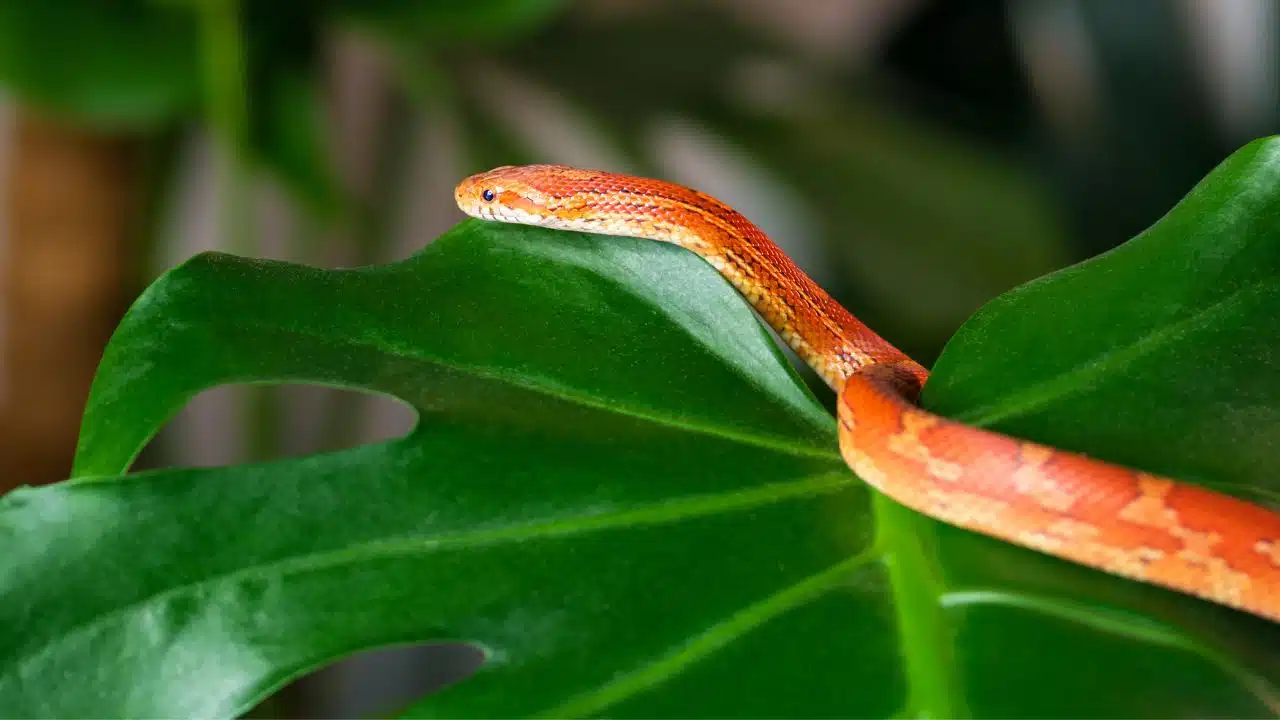Once upon a time, the Hawaiian Islands were a snakeless paradise. But that was long before it became a go-to vacation destination. Nowadays, those with a healthy fear of snakes may be disheartened to learn that several reptiles have found their way to the shores of the Aloha State. But just because you can find snakes in Hawaii now doesn’t make the islands feel any less like paradise. And before you let your fear of slithering serpents waylay your travel plans, it’s worth considering just how, if at all, the presence of snakes will feature on your island getaway. So, to help you out, here’s your guide to snakes in Hawaii.
Table of Contents
Does Hawaii Have Snakes?
Hawaii has no native snakes. But, unfortunately, that doesn’t mean it’s snake-free. The islands have seen their fair share of snake species thanks to travel, stowaways, and illegal smuggling. However, Hawaii is far from overrun, in part, thanks to the fact that it’s illegal to own snakes.
All snakes in Hawaii have two things in common: they’re invasive and illegal. Hawaii’s isolated location has resulted in a delicately balanced ecosystem. The introduction of invasive predators like snakes, with no natural predators themselves, has the potential to devastate Hawaii’s native wildlife populations. Because of the potential threat to native species, Hawaii made it illegal to own a pet snake on the islands. Perpetrators can face fines of up to $200,000 and three years of jail time, though owners can receive amnesty if they willingly turn any pet snakes over.
Because of the state’s zero-tolerance policy, visitors won’t have to worry too much about run-ins with snakes in Hawaii. In fact, you’re probably more likely to run into a shark than you are a snake—and before you get too worried, there’s very little chance of running into the kings of the ocean, either.
How Common Are Snakes in Hawaii?
Thankfully, what snakes you find in Hawaii aren’t all that common. Or, at least, they’re not commonly sighted. The two most prevalent types of snakes in Hawaii are the Brahminy Blind Snake, also known as the Island Blind snake, and the yellow-bellied sea snake.
It’s rare to see either of Hawaii’s most common snakes out and about in the wild. When you do, the Brahminy Blind snake is relatively harmless. But, if you come across a yellow-bellied sea snake, it’s best to keep your distance, as they come equipped with venom strong enough to cause paralysis.
Are There Poisonous Snakes in Hawaii?
Speaking of the venomous (often mistakenly called poisonous) yellow-bellied sea snake, this is one of only two venomous snakes on the Hawaiian Islands. The second is the brown tree snake. However, the brown tree snake is only mildly venomous compared to its sea counterpart.
Of course, that’s not to say that venomous snakes are the only ones to watch out for in Hawaii. The islands have had a number of scares with varied types of nonvenomous serpents, including ball pythons and boa constrictors.
9 Snakes in Hawaii
The Hawaiian Islands have had their fair share of encounters with illegal animals, from exotic snakes like the boa constrictor to the everyday reptiles common across North America, like the garter snake. But exotic or not, they’re all rare in Hawaii (with one notable exception). So, here are the snakes you may—but likely won’t—run into on the islands.
Nonvenomous Snakes in Hawaii
The majority of snakes spotted in Hawaii are nonvenomous. But while that makes them less dangerous to humans, it doesn’t make them any less dangerous to the Hawaiian ecosystem. So, if you see one of these creepers crawling around Hawaii, be sure to give the Hawaii Department of Agriculture (HDOA) a call.
1. Ball Python
Ball pythons are nonvenomous snakes often kept as exotic pets in the United States. What starts as a cute and small snake quickly grows from several inches to several feet long. And while they don’t pose much of a danger to humans, they can cause irreparable damage to the native wildlife and Hawaii’s populations of birds and small mammals when they escape into the wilds.
Despite regulations from the Hawaiian government, the islands have seen several ball python sightings over the past decade. The most recent include one found in Hilo in 2020 and another in Honolulu in 2021.
2. Brahminy Blind Snake
Hawaii doesn’t have any native species of snake. That said, the Brahminy Blind snake has been around so long that many consider it a Hawaii native. Measuring only six inches in length, Brahminy Blind snakes are one of the smallest snake species in the world. If you spot it out in the wild, you may even mistake its slim frame for an earthworm, and its size is one reason another name for this creature is flowerpot snake.
Since its introduction to Hawaii’s shores, the Brahminy snake has built a significant population. While this would be a cause for concern with any other species, its harmless nature poses no threat to the Hawaiian ecosystem. In fact, many people appreciate its presence thanks to its feeding patterns—a steady diet of ants and termites.
3. Corn Snake
Known to reach up to six feet in length, corn snakes are abundant in southeastern states like Florida. The biggest concern with these serpents is their ravenous appetite. Eating every few days, they chow down on everything from lizards and tree frogs (babies) to rats and birds (adults). These snakes pose little threat on the mainland, but on the Hawaiian Islands, they could quickly take over as an invasive predator.
Luckily, only one corn snake has ever been found on the Hawaiian Islands. After being spotted in someone’s backyard, it was quickly captured by police and turned over to the HDOA.
4. Garter Snake
The garter snake is recognizable for its distinct pattern of three stripes down its back. However, with over thirty-five different species, its appearance can vary. What doesn’t vary, thankfully, is its relative harmlessness. Garter snakes are technically venomous, but their venom is only strong enough to cause slight swelling if you get bit.
While garters are pretty common in North America, the same can’t be said about Hawaii. The islands have only had a few meetings with these colorful critters; both incidents involve Christmas trees. The first occurred in 2004, when a garter snake was found in a Christmas tree shipment in Kailua, while the second was discovered in 2020, during a secondary inspection of a shipment in Honolulu. Thankfully, despite their Christmas tree incursion, the islands have remained relatively garter free.
5. Boa Constrictor
The boa constrictor is another popular pet among exotic snake owners thanks to its striking look and large size. Boa constrictors have distinctive markings with varied colors and patterns and can grow as large as twelve feet long. Unfortunately, because of their exotic nature, boa constrictors are even more likely than ball pythons to be smuggled into Hawaii. Consequently, there have been far more boa sightings on the islands stretching back over the past decade. The largest was a nine-foot boa constrictor captured by pig farmers in 2011. Others have been turned over to the HDOA or found along the highway.
Because boa constrictors are land snakes that eat birds and other native wildlife, they could wreak absolute havoc on Hawaii’s native populations if left unchecked.
6. Southern Black Racer
Sometimes mistaken for its venomous counterpart, the cottonmouth, the southern black racer is far less terrifying. Nonvenomous, its thin body, jet black coloring, and white chin help identify it from other snakes it might be confused for. And unlike many other snakes on this list, the southern black racer is active during the day, meaning you’re much more likely to spot it.
However, considering the only reported sighting of this snake was a backpack stowaway from Florida in 2019, you’re not likely to encounter this particular snake on your next trip to Hawaii.
7. Gopher Snake
Long and muscular, the gopher snake’s appearance is far more frightening than the actual reptile. Though powerful, the gopher is a relatively benign, nonvenomous snake. It primarily feeds on small mammals, birds, bird eggs, and, of course, gophers. In North America, they do an excellent job of keeping rodent populations in check. However, their hunting skills could quickly grow out of control in Hawaii, where the native bird populations are unused to the threat of terrestrial snakes.
Only a few incidents of gopher snake sightings have been reported over the last several years. One was found in a shipping container in 2014, while just this past summer, police captured another gopher snake in the aisles of a Home Depot in Honolulu.
Venomous Snakes in Hawaii
If you’re worried about deadly snake bites—don’t be. Venomous snakes in Hawaii are few and far between. Still, the islands have had a few troubling encounters in the past that make seeing these serpents a possibility, however unlikely that is. So, if you come across either of these snakes, keep your distance and call the HDOA immediately.
7. Brown Tree Snake
You shouldn’t have to keep too close an eye out for these serpents or their cat-like eyes. Brown tree snakes have an interesting story in Hawaii. Only eight have been found on the islands between 1981 and 1998.
However, if left to propagate, the brown tree snake could pose a serious threat to Hawaii’s native species. After being accidentally introduced to Guam in the 1950s, brown tree snakes all but wiped out the island’s native bird population. Because they eat small mammals, birds, and other creatures—and have no natural predators in Hawaii—it’s feared a similar story could occur in the Aloha State if they managed to smuggle their way in.
So, to keep that from happening, the Hawaiian government imported them to the islands. While importing them might seem counterintuitive, their purpose is preventative. Four sterile brown tree snakes were brought to the islands in 2018 to help train dogs to hunt for them in plane and boat cargo.
8. Yellow-Bellied Sea Snake
Yellow-bellied sea snakes are the most “native” it gets for snakes in Hawaii. Identifiable by its black back and bright yellow belly, the sea snake is an aquatic species found off the shores of Hawaii. However, it rarely comes on land, which is a good thing, considering it’s the most venomous snake on the islands. Its toxins are strong enough to cause paralysis and can even be fatal if left untreated.
But despite its dangerous bite, there are actually no reports of a yellow-bellied sea snake attacking anyone in Hawaii. Overall, they are timid and more likely to hide than attack. So, if you see one, it’s best to keep your distance and call the HDOA.
Next Vacay Can Find You Your Ticket to Paradise
Hawaii is snake-free in all the ways that count. When your odds of seeing a shark in the water are better than seeing a snake on land, those odds make for a pretty great island getaway. And with Next Vacay, scoring your tickets to paradise just got a whole lot easier.
With customized and vetted deals delivered to your inbox, you never have to worry about expensive flights again—or missing out on the perfect deal. Because Next Vacay knows that the only thing better than a snake-free vacation in the tropics is saving your money on a great flight that gets you there. So, plan your stress-free retreat with Next Vacay, and you’ll be soaking in the Hawaiian sun in no time.



